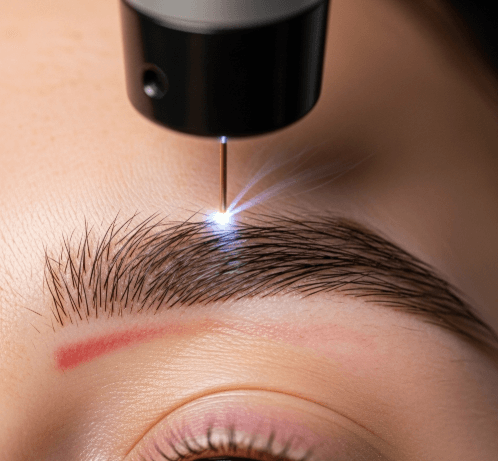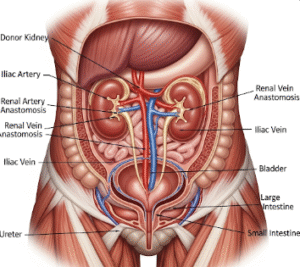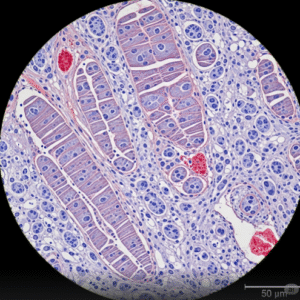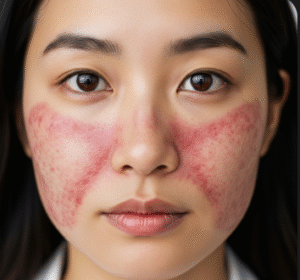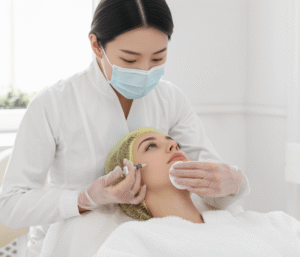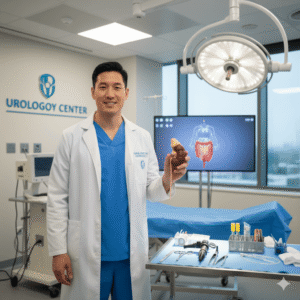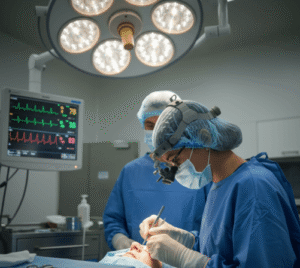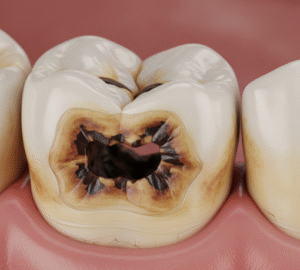What it is
Microblading removal in Korea is a cosmetic and dermatological treatment that aims to reduce or completely remove unwanted semi-permanent eyebrow tattoos created through microblading.
Microblading uses pigment implanted in the upper dermis of the skin through fine strokes to mimic natural eyebrow hairs. Over time, pigment may blur, discolor, or appear unnatural, leading many people to seek removal.
→ Microblading removal differs from standard tattoo removal because pigments are typically deposited more superficially and may contain cosmetic ink formulas that respond differently to lasers.
• In Korea, removal methods commonly include Pico or Q-switched lasers, saline removal, or a combination of both, depending on pigment color and skin type.
• The goal is to fade the unwanted pigment while keeping the surrounding brow skin healthy and ready for possible correction or reapplication.
Why it’s done
There are many reasons why clients choose microblading removal in Korea:
→ Unnatural results: Microblading strokes may heal poorly, creating thick or blurred lines.
→ Pigment color change: Ink can fade to unwanted shades like red, blue, or gray over time.
→ Incorrect shape: Poorly done brows may not match the client’s face or symmetry preferences.
→ Desire for new style: Beauty standards and personal preferences evolve; some clients want thinner, softer, or differently shaped brows.
→ Professional correction: Removal is often the first step before corrective microblading or powder brows are applied.
Alternatives
Besides professional removal, other alternative methods are sometimes considered:
• Cover-up brows → Adding new pigment over old strokes; however, this often creates heavy, unnatural results if the old pigment is too dark.
• Makeup → Using brow pencils or concealer to mask the pigment daily.
• Chemical creams → Marketed for removal, but typically ineffective and may irritate delicate eyebrow skin.
• Dermabrasion or excision → Aggressive techniques that are rarely used, as they can cause scarring or hair loss in the brow area.
→ Compared to these, laser and saline removal in Korea are far safer, more effective, and allow gradual fading with less risk.
Preparation
To ensure the best outcome, preparation for microblading removal in Korea involves several steps:
- Consultation → A dermatologist or brow correction specialist evaluates pigment color, depth, and the number of previous touch-ups.
- Skin assessment → Sensitive or thin skin around the eyebrows is checked carefully.
- Avoid sun exposure → Direct sun increases risks of pigmentation changes post-treatment.
- Pause actives → Retinoids, acids, or exfoliating products around the brow area should be stopped.
- Clean brows → On treatment day, the brow area should be free of makeup, creams, or oils.
→ A topical numbing cream is usually applied in Korean clinics to maximize comfort during the procedure.
How it’s done
Microblading removal in Korea is typically performed using one of two main approaches:
- Laser method
- A Pico or Q-switched laser is used to target pigment particles.
- The laser emits ultra-short pulses that shatter the cosmetic pigment into smaller fragments.
- The body gradually absorbs and eliminates these fragments.
- Saline method
- A saline solution is tattooed into the brows using specialized needles.
- The solution draws pigment out of the skin, forming scabs that naturally lift color as they heal.
→ Each session lasts 20–40 minutes.
→ Multiple sessions are usually required: 2–6 treatments, spaced 6–8 weeks apart, depending on pigment depth and how the skin responds.
Recovery
Recovery after microblading removal in Korea is generally mild but requires attentive care:
• Redness and sensitivity → Normal for a few hours to days.
• Scabbing → Especially common after saline removal; scabs must be left alone until they fall naturally.
• Darkening before fading → Pigment may look darker immediately after laser treatment before gradually lightening.
• Avoid moisture and heat → Saunas, sweating, and swimming should be avoided for 5–7 days.
• Sun protection → SPF 50+ sunscreen must be applied to prevent uneven pigmentation.
→ Most patients return to daily routines immediately, but the treated area should be handled gently until fully healed.
Complication
While microblading removal is safe in Korea, possible complications include:
- Temporary pigmentation changes → Skin may darken (hyperpigmentation) or lighten (hypopigmentation).
- Blistering or scabbing → Generally mild and temporary.
- Scarring → Rare, but can happen if scabs are picked or poor aftercare is followed.
- Incomplete removal → Some cosmetic pigments contain titanium dioxide or iron oxide, which are more resistant.
- Allergic reactions → Rare, but possible if pigments break down into reactive compounds.
→ Skilled Korean practitioners use advanced lasers and techniques, minimizing these risks.
Treatment option in Korea
Korea is a global hub for advanced eyebrow correction and removal treatments.
→ Laser options → Leading clinics use cutting-edge PicoSure, PicoWay, and Nd:YAG systems that are effective for cosmetic inks.
→ Saline removal → Widely offered, especially for patients with pigment types not responsive to lasers.
• Aesthetic focus → Korean specialists are trained not only in removal but also in preparing the skin for new, natural-looking brow corrections.
• Combination therapies → Some clinics combine fading sessions with healing treatments, such as LED therapy or growth factor serums, to keep skin healthy and speed recovery.
• Medical tourism → Many international clients travel to Korea for microblading removal, attracted by the expertise of Korean dermatologists and PMU specialists.
→ With state-of-the-art equipment and a reputation for precision, Korea offers some of the safest and most effective microblading removal options in the world, often paving the way for beautifully restored or corrected eyebrows.

